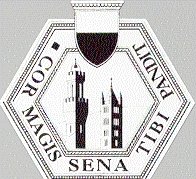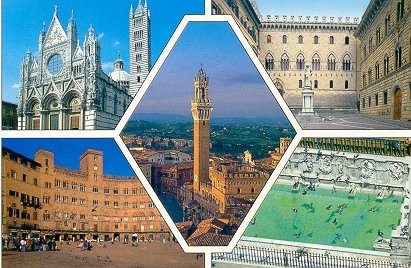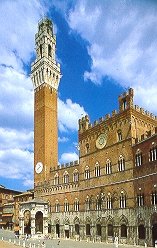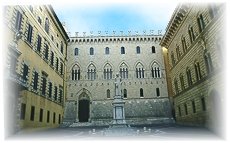
cittadino |
 |

cittadino |
 |
 Dalla
Lizza, attraverso Piazza Gramsci, si giunge alla novecentesca Piazza Matteotti,
quindi per via Curtatone fino alla Chiesa di San Domenico, con bellissima
vista del Duomo e del campanile. Risalendo la via della Sapienza, si incontra
la Biblioteca degli Intronati, dove sono conservate preziose raccolte di
manoscritti e incunaboli, e, più avanti, il Museo Archeologico Nazionale,
con reperti in gran parte etruschi provenienti dal Contado, di fondamentale
importanza per chi vuole capire la storia delle più lontane origini
del territorio. Dalla
Lizza, attraverso Piazza Gramsci, si giunge alla novecentesca Piazza Matteotti,
quindi per via Curtatone fino alla Chiesa di San Domenico, con bellissima
vista del Duomo e del campanile. Risalendo la via della Sapienza, si incontra
la Biblioteca degli Intronati, dove sono conservate preziose raccolte di
manoscritti e incunaboli, e, più avanti, il Museo Archeologico Nazionale,
con reperti in gran parte etruschi provenienti dal Contado, di fondamentale
importanza per chi vuole capire la storia delle più lontane origini
del territorio.
Si giunge quindi nella Piazza Salimbeni con l'omonimo
palazzo del XIV secolo, restaurato e attualmente sede del Monte dei Paschi
di Siena, che contiene anche l'archivio storico della banca. Attraverso le vie dell'Oliviera e di San Girolamo si giunge alla via Salicotto che attraversa l'area dell'antico ghetto il cui tessuto originario è stato sconvolto da pesanti interventi urbanistici. Al termine piazza del Mercato: qui la vista spazia da un lato verso il tratto di mura che va da Porta Tufi a Porta Romana e dall'altro sul retro imponente del Palazzo Pubblico: Si sale quindi al Casato di Sotto e al Casato di Sopra dove è conservata una bella edilizia medioevale. All'altezza di via San Pietro si piega a sinistra e, oltre l'arco di Sant'Agostino, si apre un ampio prato fiancheggiato dall'omonima Chiesa del XIII secolo e rimaneggiata nel XVIII. Nelle adiacenze i Musei dell'Accademia dei Fisiocratici, con raccolte di campioni di rocce e fossili del Pliocene senese e il bell'Orto Botanico. Imboccando via delle Cerchia si raggiunge il Piano dei Mantellini e la Chiesa di Santa Maria del Carmine, con bella facciata e capanna, rimaneggiata nel XVI secolo. Dopo l'arco delle Due Porte, facente parte delle mura dell'XI secolo, si giunge per via Mascagni a Porta Laterina. Tornando per via Mascagni e quindi per via Stalloreggi, fiancheggiata da notevoli case antiche, in via Castelvecchio e in via San Pietro si incontra il Palazzo Bonsignori, costruito nel XV secolo, uno dei più bei palazzi privati: è oggi sede della Pinacoteca Nazionale, tappa obbligata per chi voglia conoscere l'evoluzione della pittura senese dalle origini. Si prosegue per via di Città, fino alla Croce del Travaglio, dove termina la prima parte di questo percorso cittadino. |
This itinerary begins at Porta Camollia (the arch above the door bears the Latin inscription "Cor magis Sena tibi pandit", which means that the city opens its heart wider than its doors), one of the entry-ways to the historical center of Siena which opens outward to the old road to Florence, the ancient Via Francigena. Following Via Camollia we reach the Lizza, a public garden, enlarged and restructured in 1872, that is situated in front of the Forte di Santa Barbera, a fortress built by Cosimo I of the Medici family after the Florentine conquest of Siena. Demilitarized and opened to the public in 1778, the Fortress is today home of the Enoteca Italiana (Italian Wine Center). Continuing past the Lizza and crossing Piazza Gramsci, we reach the twentieth century Piazza Matteotti, then proceeding down Via Curtatone we arrive at the church San Domenico from which one can admire a beautiful view of the Duomo (cathedral) and its bell tower. A climb up Via della Sapienza leads to the City Library of the Intronati, where priceless manuscripts and incunabulum are conserved. Further along, we come to the Museo Archeologico Nazionale (National Archeological Museum), which houses mostly Etruscan finds from the surrounding countryside, of fundamental importance for those who want to understand the earliest origins of this territory. A little further along we come to Piazza Salimbeni with its fourteenth century palace of the same name. The palace has been restored and is the headquarters of the banking institution Monte dei Paschi di Siena. The historic archives of the bank are also stored there. Returning to walk along the animated Via Banca di Sopra and then turning down Via dei Rossi, we arrive at Piazza di San Francesco with its Basilica of the same name that was constructed in the fourteenth century and reworked in the nineteenth and twentieth centuries. The Church of Santa Maria Provenzana, built in the fourteenth century, dominates the nearby Piazza Provenzana. From its terraces one can enjoy beautiful views of the ancient city walls and the hills to the southeast of Siena. Crossing Via Allustio Bandini (a typical street from the 1200s) and walking alongside the building that is the seat of the university, we enter into Via Banchi di Sotto. On the corner of Via Rinaldini stands Palazzo Piccolomini, representing the typical style of the Florentine Renaissance, which is now seat of the State Archives where the tablets of Biccherna (the ancient tablets of the state ledgers) are conserved. Further along, near the Church of San Martino, are the Logge del Papa, built in 1462 by Pope Pio II in honor of his family. We then proceed down Via Pantaneto, the principal street of the Third of San Martino, and then down Via dei Pispini, which opens to the street to Arezzo. Crossing Via dell'Oliviera and Via di San Girolamo we reach Via Salicotto. This road runs through the ancient getto, whose original features have been ruined by heavy interventions of city-planning. At the end of the road lies Piazza Mercato: here the view spreads from, on one side, the section of the ancient city walls that stretches from Porta Tufi to Porta Romana to, on the other side, the back of the imposing Palazzo Pubblico (City Hall). We climb, then, to the Casato di Sotto and the Casato di Sopra where a beautiful medieval housing building is conserved. At the top of Via San Pietro then to the left and past the arch of Sant'Agostino, a large lawn opens up alongside the church of the same name that was built in the thirteenth century and renovated in the eighteenth century.  Adjacent
to the church are the Museums of the Academy of the Physiocrats which house
collections of rock and fossil samples from the Sienese Pliocene era as
well as the beautiful Botanical Gardens. Turning into Via delle Cerchia
we reach the Piano dei Mantellini and the Church of Santa Maria del Carmine,
with its gorgeous façade and bell tower, renovated in the sixteenth
century. Passing the arch of the Due Porte, which is part of the
eleventh century city walls, we arrive at Via Mascagni at Porta Laterina.
Returning by way of Via Mascagni and then Via Stalloreggi, which is lined
with notable ancient homes, in Via Castelvecchio and in Via San Pietro
we find Palazzo Bonsignori, which was built in the fifteenth century and
is one of the most beautiful private palaces in Siena. Today it is
the seat of the Pinacoteca Nazionale (National Picture-Gallery), an obligatory
stop for those who wish to understand the evolution of Sienese painting
since its origins. From here, we continue along Via di Città
to the Croce del Travaglio where the first part of this route through the
city ends Adjacent
to the church are the Museums of the Academy of the Physiocrats which house
collections of rock and fossil samples from the Sienese Pliocene era as
well as the beautiful Botanical Gardens. Turning into Via delle Cerchia
we reach the Piano dei Mantellini and the Church of Santa Maria del Carmine,
with its gorgeous façade and bell tower, renovated in the sixteenth
century. Passing the arch of the Due Porte, which is part of the
eleventh century city walls, we arrive at Via Mascagni at Porta Laterina.
Returning by way of Via Mascagni and then Via Stalloreggi, which is lined
with notable ancient homes, in Via Castelvecchio and in Via San Pietro
we find Palazzo Bonsignori, which was built in the fifteenth century and
is one of the most beautiful private palaces in Siena. Today it is
the seat of the Pinacoteca Nazionale (National Picture-Gallery), an obligatory
stop for those who wish to understand the evolution of Sienese painting
since its origins. From here, we continue along Via di Città
to the Croce del Travaglio where the first part of this route through the
city ends |